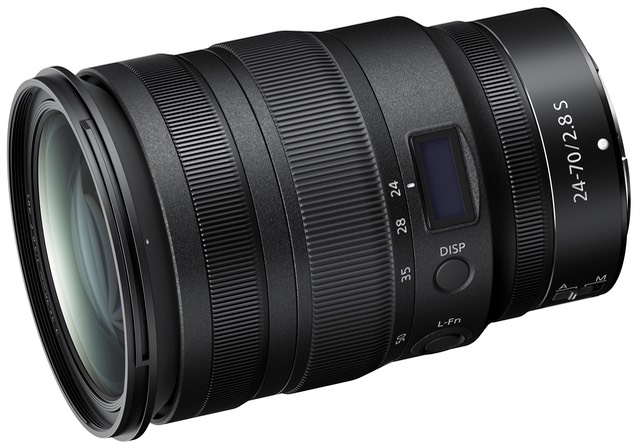
What Is It?
The 24-70mm f/2.8 S, while the fifth lens to sport the S badge, is really the start of something new in the Z lens lineup: truly professional caliber lenses, with high performance and extra features.
Even a cursory examination reveals some of the features: integrated display, a Lens FN button, and a third (programmable) ring. The f/2.8 aperture on a mid-range zoom immediately puts this lens into a performance expectation matching the pro mid-range zooms in the long-existing mounts (e.g. Nikon's own 24-70mm f/2.8G and f/2.8E in the F-mount).
That the fifth lens duplicates the first lens's focal length (24-70mm) is surprising to many, but it doesn't strike me as surprising at all. Nikon has clearly indicated that they'll be doing two sets of the basic lens zoom trio: f/2.8 aperture high performance lenses (14-24mm, 24-70mm, and 70-200mm) and f/4 lenses that are more svelte and travel friendly (14-30mm, 24-70mm, and the leaked 70-200mm but not yet on the official Z Lens Road Map, likely to appear in late 2020).
The first difference you note in the 24-70mm f/2.8 and f/4 pair—other than the extra features mentioned above—is size and weight. Let's put that in numbers:
| f/2.8 S |
f/2.8E | f/4 S |
|
|---|---|---|---|
| weight | 28.4 ounces (805g) |
38.4 ounces (1070g) | 17.7 ounces (500g) |
| length |
5" (126mm) |
6" (155mm) |
3.5" (89mm) |
| price | US$2300 | US$2400* | US$1000* |
* The f/2.8E is on sale as I write this and the f/4 S lens is discounted in body kits; these are the MSRPs.
A lot of folk are going to look at that table and be surprised, I think. The nasty rap that full frame mirrorless cameras have gotten is "...but the lenses are just as big and heavy as are DSLR lenses." That's never been entirely true, though one-and-a-half pounds is hardly light and 5" is hardly small. Still, one thing that immediately struck me in moving from my D850 and the 24-70mm f/2.8E lens to the Z6 and the 24-70mm f/2.8 S lens: yes, that was a smaller and lighter enough combination to be quite noticeable.
Unlike the f/4 S, the f/2.8 S does not have a shorter storage position you have to unclick the zoom from in order to start using it. The f/2.8 S is shortest at 24mm and ready to shoot. Zooming to 70mm lengthens the lens by a little over an inch. Focusing does not change the length (all focusing is internal).
Speaking of focus, we get these numbers:
| f/2.8 S |
f/2.8E | f/4 S |
|
|---|---|---|---|
| close focus |
15" (.38m) |
15" (.38m) | 12" (.3m) |
| maximum magnification |
1:4.5 |
1:3.7 |
1:3.3 |
Nikon basically gave up a little bit at the close end with the f/2.8 S. Though like the f/4 S the Z cameras make the f/2.8 S work very much like a parfocal lens—little or no focus or focal length breathing—rather than the varizoom the f/2.8E is. Focus is via a fast and near silent stepping motor (ala the AF-P and other Z lenses). In this lens, two different groups of elements are driven during focus operations, a trend that is heating up in lens design lately. Positioning multiple elements simultaneously allows for more optical correction in zooms lenses, and more compact designs.
All recent Nikkors, including the one being reviewed, have been weather sealed, though there's a bit more going on with the gasketing on the f/2.8 S than we're used to (as you might expect given its extra rings and controls).
The Lens Fn button is controlled by Custom Setting #F2 in the cameras, and can be set to 21 different functions. DOF Preview is one of those and probably the right one to choose if you don't have a specific other preference. The extra ring on the lens can only be set to three things: aperture, manual override focus (M/A), and exposure compensation.
The organic EL display on the top of the lens is not always on. You have to press the DISP button on the lens to get it to display (a power saving "feature"). Pressing that button also won't wake the camera from sleep, by the way. Pressing the DISP button cycles through aperture, focal length, and focus information. That focus information includes depth of field, which I'll get to in the handling section, below.
Aside: I don't get it. If this information is available to display on the lens, why aren't we able to see it in the viewfinder? The current implementation of these lens displays—not just Nikon's—feels more like an engineering project than an attempt to solve user problems.
In terms of optics, Nikon has a rather modest 17 elements in 15 groups. I say modest, because the tendency recently with professional level zooms is to throw a lot of glass at dealing with the optical tradeoffs. Filter size is 82mm. Nikon makes an optional thin 82mm circular polarizer for the lens.
Four of those elements are aspherical, two are ED (low dispersion) glass. Nikon adds a second flare/ghost control coating to the Nano coating we've seen recently, with something they call Arneo. Nikon hasn't done a lot of explaining about these coatings, but Nano works by controlling incidental light coming at an element diagonally, while Arneo controls incidental light coming at it more perpendicularly.
Nine blades form the aperture diaphragm in the lens.
On the frontmost element we get the now ubiquitous fluorine coating that repels water, dust, and even some forms of grease and fingerprints.
The lens comes with the HB-87 petal-shaped bayonet lens hood and a soft cloth wrap. The lens hood has a matte baffle on the inside rather than the usual plastic grooves. I prefer this to keep light reflections down, but the baffle does tend to collect dust if you're not careful.
The lens is made in Japan and lists for US$2300.
Source of the reviewed lens: purchased
Nikon's page for the 24-70mm f/2.8 S lens
How's it Handle?
One thing that struck me is that the 24-70mm f/2.8 S is surprisingly well balanced on the Z6 and Z7 bodies. Yes, the combination is more front-heavy than with the f/4 S zoom, but I didn't find that picking up the camera by the grip resulted in me feeling like gravity was pulling the front down.
After playing with the two mid-range zooms for a bit and thinking about it, I'd say that the f/4 S (and the 14-30mm f/4 S) basically aren't putting enough weight out front to be noticed at all: it's the body that's packing the meat, particularly if you put an L-bracket on your cameras like I tend to. In other words, the f/4 lenses just don't pull the camera down in the front at all, the center of gravity is remarkably close to the lens mount.
The f/2.8 S zoom clearly has more heft out front, but it, too, creates a center of gravity that's nearer to the mount than I would have expected. Thus my conclusion: reasonably well balanced. That said, we're up around 3 pounds (1361g) with camera and lens here, so the combo isn't all that light. I'm just saying that the camera and lens feels pretty well-balanced to me while shooting.
While the lens doesn't have built-in VR, it communicates with the Z cameras and takes advantage of the sensor-based VR. I do wish Nikon had put a VR control switch on this lens, though. Having to menu dive to turn VR on and off is a bit of a pain.
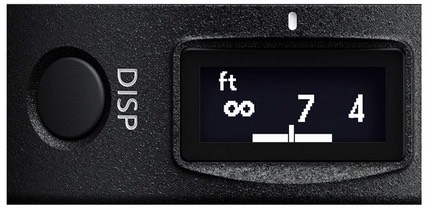
The white bar at the bottom is the DOF, the little stick-up line in the middle is the current focus position. So, can you tell me what will be in focus?
The 24-70mm's small organic EL display can show depth of field. I'm not at all sure how useful this is, as we have no indication of what criteria Nikon used to calculate DOF, nor how precise the actual information is. In the illustration above, is the DOF 5' to infinity, or to near infinity, or is it something other than from 5'? Difficult to tell.
Also problematic is that the bar that reveals the DOF is at the bottom of the lens display, which is recessed. That means that just peaking over the top of the camera to see the DOF indicator doesn't work: the back edge of the lens housing cuts off your view of the DOF bar. You pretty much have to look at the lens display from the top to see the DOF markings fully.
What is interesting and potentially useful is that the DOF bar works for all apertures, even f/2.8. It's going to take some trial and error to understand how to interpret the bar, but this is still potentially useful for some shooters once they figure out how to interpret the information.
I'm glad that the third ring is a bit recessed from the overall barrel diameter and back near the mount. If you set that ring to aperture or exposure compensation, any small inadvertent touch can change a setting you probably don't want to change. It would have been nice if Nikon included a lock switch on the extra ring (e.g. a way to turn it on and off on demand), but I didn't find myself accidentally triggering changes nearly as much as I expected to. For video shooters, the extra ring is a nice addition.
Overall, this is a nicely designed lens with no major handling quibbles, though the extra display feature seems a bit underwhelming compared to what I could imagine it to be.
How's it Perform?
Focusing: Precise and fast, as you'd expect with the STM motors Nikon is using in the Z system (and AF-P lenses in the F-mount). I will say that the focus move itself is usually quieter on the f/2.8 S lens than it is on the f/4 S. There's a clear whir on the f/4 with most focus moves, but more of a whisper on the f/2.8.
Sharpness: Nikon's MTF graphs suggested that the f/2.8 S was going to be a better behaved 24-70mm than Nikon has made before, and that is proved out in the shooting. There may be specific focal length/aperture points where another zoom beats the f/2.8 S, but overall, this new Z lens hits high marks in so many ways. For instance, I see very little field curvature (there's a bit at the wide end, but nothing I'd be concerned about).
But you want to know about sharpness: simple answer, it's sharp. Center to the DX corners goes from excellent to very good wide open at 24mm, and even the corners aren't all that bad, probably something I'd rate as good for f/2.8. Moreover, this performance at 24mm is clearly better than the 24-70mm f/2.8E in the F-mount. Moreover, it's better than the 24-70mm f/4 S across the frame and in the corners at 24mm and f/4 in a way that many people will notice. So if critical acuity is something you seek across the frame at 24mm, the 24-70mm f/2.8 S is the best zoom we've seen to date wide open, and even regardless of aperture (obviously as we stop down some of the others start to approach it).
This performance mostly repeats through the zoom range (some other lenses may match the f/2.8 S in the center, but none do by the time you get to the corners). But there's a strange anomaly to report: corners soften a bit wide open by 35mm, then snap back big time at 50mm, then soften a bit again at 70mm. I've not seen a yo-yo-ing wide open corner performance like that before.
By f/5.6, this new zoom changes my expectations out of a mid-range zoom at pretty much any focal length: we're getting into near prime territory with the corners at some focal lengths (the center is always excellent and snappy, even wide open).
The lens is weakest at 70mm. At f/4 and 70mm, the 24-70mm f/4 S starts to get very close to the f/2.8 S performance in the corners, and the F-mount 24-70mm f/2.8E probably is just a bit better in the corners (but not the center). But this is still what I'd call very good to excellent, depending upon the aperture you select. One extra note about the 50-70mm range: the center is a little weaker at f/2.8 than it is a 24-50mm, though that disappears by f/4.
As with most recent Nikkors, the 24-70mm f/2.8 S seems to have little coma and spherical aberration in the corners. I can see a wee bit of smearing, but frankly, for a zoom, this is excellent performance that really isn't really going to impact your images, even shooting star fields.
I'm not finding any significant focus shift in the lens (the f/4 zoom had some).
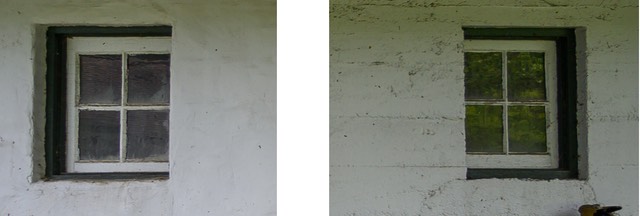
Let's look at 24mm for a moment. Even at the f/8 aperture this was shot at, typically we'd see very visible chromatic aberration and smearing in the corners.

This is the upper left corner. It's clean and renders detail just fine. The little bit of acuity loss here is due to DOF—this corner isn't exactly at the focal plane—rather than the lens itself. I normally don't think of any mid-range zoom as a potential landscape lens due to corner issues, but the 24-70mm f/2.8 S does just fine with landscape and architectural shooting. It was probably my biggest surprise with the lens.
Linear Distortion: With no in-camera or conversion correction applied, the lens has significant barrel distortion (almost 3%) at 24mm, and significant pincushion distortion (again almost 3%) at 70mm. The crossover point between types of distortion is somewhere near 28mm. The uncorrected linearity is not quite as bad as the 24-70mm f/4 S, but definitely you'll often want to correct linearity at the extreme focal lengths, given the amount.
Vignetting: Significant vignetting of about two stops at 24mm and f/2.8. The vignetting never really reduces to insignificance at 24mm. There's still a full stop worth at f/16. By 35mm, things settle down more as you'd expect them to, with moderate vignetting wide open—maybe one and a half stops—and reducing to a stop or less by the time you hit f/4.
Chromatic aberration: Longitudinal chromatic aberration seems remarkably low for a fast lens. Lateral chromatic aberration is also excellent at 70mm, very good at 24mm, and superb—not a word I use a lot—at 50mm.
Flare: Well controlled. You can produce some, and it will tend towards green/blue coloration, but it's relatively minimal, and certainly less than we saw with the F-mount lenses. Ghosting is indeed minimal, as Nikon's claims on Nano and Arneo coatings would suggest.
Bokeh: A fair amount of onion skin on bright light sources out of focus, surprisingly. Plus in the corners we get some cats-eye distortion of any point source blur circle. That said, as with many recent Nikkors I find the transition from focus to out-of-focus to be well handled, and because we don't have added coloration or bright edging on the blur circles of point sources, I'm not at all unhappy with the bokeh. I actually like it.
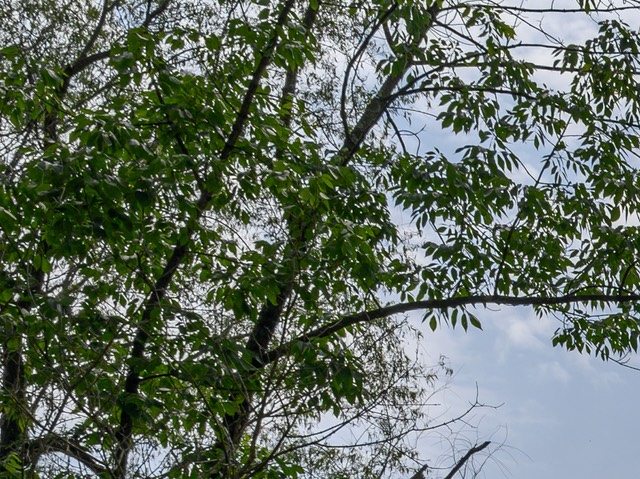
I don't normally try to show bokeh on the Web, as the small images and image resizer I use on the site can definitely mask what I see on my full display. But here goes, let's give it a try. The above is the full frame at f/2.8, with focus set to just a bit in from the right edge of the tree trunk.
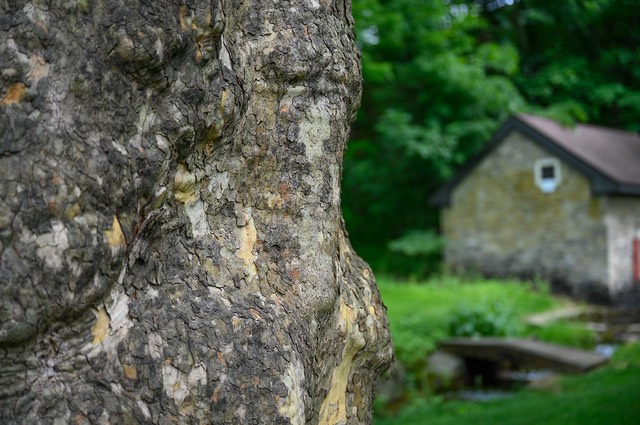
Focus falls away fairly gracefully (the focus point is at the far left of this crop, so you can see how the drift to out of focus goes as you progress to the knot at the near center bottom), and out of focus backgrounds generally don't show any anomalies that would call attention to them. There's an interesting "softness" to the out-of-focus areas that has very little complexity to it. I happen to like this. You might not. (There's no "standard" for bokeh, it's a "when I see it I'll know" kind of attribute for most people.
Final Words
I wasn't actually expecting to like this lens, to tell the truth. Bigger and heaver than the highly competent f/4 version, coupled with seeming gimmicks like the organic EL display and extra ring, plus the much higher price, and the f/2.8 S just all seemed a little off-putting on paper.
On camera and in pixels, it's a different story. This lens performs. So much so that I'm not sure what I'd tell Nikon to improve on the next version in terms of optics (I'd be afraid if they lowered the linear distortion, something else would get worse, and I don't want that). There's a really nice balance going on here that is essentially at state-of-the-art. The 24-70mm f/2.8 S is arguably the best zoom lens of that focal range I've seen to date, certainly the best I've fully tested and measured.
Despite the 82mm filter ring up front, compared to the F-mount 24-70mm f/2.8E the Z version is shorter (at 24mm, by 1" or 28.5mm) and lighter (by 10 ounces, or 265g). That puts it right in a class that feels just about right on the Z bodies, particularly when you've got an Arca-style L plate installed (or anything that adds just a bit of heft to the body).
Which leaves us at the US$2300 price. That's well more than a Z6 body. Yet those that are in need of that f/2.8 aperture or the ultimate zoom acuity aren't really going to be put off by that, I think. I'd certainly say Nikon's picked a reasonable price for the level of optical performance you get. With the new firmware and this lens the Z6 starts to look like a much better solution than the D750 and any mid-range zoom.
I originally thought I'd pick this lens up, use it for awhile, and then sell it and fall back to just the f/4 lens. Now I'm not at all sure about that. Certainly the f/4 version is the one you want when you want to travel minimally. It more than holds its own against any other mid-range zoom. Moreover, when bought with a camera body, the price of the 24-70mm f/4 S is very much a bargain that you really shouldn't ignore.
Those that want more, though, can now find it. A stop more light, more features, and some clear additional optical quality over what the already excellent f/4 lens offers.
Nikon got this just about right. The 24-70mm f/2.8 S is an impressive lens, and speaks to what they can do with the new, less restrictive lens mount.
Recommended (2019, 2020, 2021, 2022)
Support this site by purchasing from the following advertiser:
